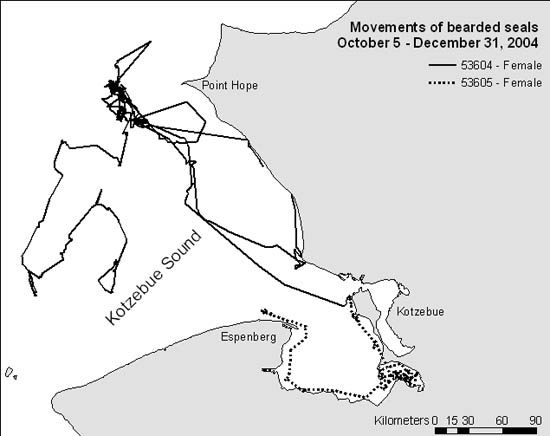Polar Ecosystems Program
Habitat Use and Seasonal Movements of Bearded Seals in Kotzebue Sound, Alaska
The movements and diving behaviors of two young-of-the-year, female bearded seals (Erignathus barbatus),
in Kotzebue Sound, Alaska, were determined remotely from satellite-linked dive recorders (SDRs). This represents
the first time that bearded seals have been tracked in U.S. waters. The project was part of a cooperative effort
with the native village of Kotzebue, the University of Alaska Fairbanks, the Alaska Department of Fish and Game
(ADF&G), and the AFSC’s Polar Ecosystems Program, and was funded, in part, by a tribal wildlife grant from the
U.S. Fish and Wildlife Service.
Bearded seals are an important Alaska Native subsistence resource. They are also a key ecological component
of arctic marine ecosystems and, because they are sensitive to suitable sea ice conditions, they may be
particularly vulnerable to climatic change. However, little is known of their seasonal movements, habitat use,
or diving behavior. This project was designed as a cooperative effort between biologists and local Kotzebue-area
hunters, and it is intended to combine local knowledge about the distribution and habits of bearded seals with
the field techniques and analysis expertise of biologists.
 |
|
Figure 1. Movements of bearded seals released near Kotzebue, Alaska. |
The first of two field seasons was conducted in October 2004. The two seals were captured in large-mesh
nets set in the shallow, open waters near Kotzebue. Upon release, one seal remained close to the coast of
inner Kotzebue Sound and the other moved into the deeper waters of the Chukchi Sea (Fig. 1 above). Despite
their different habitats, they exhibited similar patterns in the use of their surroundings. Each seal tended
to remain in a small area, presumably foraging, for a number of days (i.e., 318), before moving to a new
location, often more than 150 km away.
Further analyses of these data will include investigations of the
potential effects of bathymetry, ice concentration, and ice extent on their movements and diving behavior.
This first season has shown that it is possible to reliably and safely capture and instrument bearded seals
in this area. In our second season, planned for September and October 2005, we intend to instrument a larger
number of animals to better estimate the movements and behaviors of these animals.
By Michael Cameron
Review of Genetic Research on Harbor Seal Population Structure
The National Marine Fisheries Service (NMFS) and the Alaska Native Harbor Seal Commission (ANHSC), through
their joint Harbor Seal Comanagement Committee, requested an independent scientific peer review of recent
NMFS research on the genetic structure of harbor seal populations in Alaska. The purpose of this independent
review was to evaluate new science that has implications for stock assessment and management.
The American
Institute of Biological Sciences (AIBS), Scientific Peer Advisory and Review Service was contracted to
identify and recruit reviewers with appropriate expertise, solicit reviews, and convened a panel meeting on
12-14 October 2004 in Juneau, Alaska. Five individuals were recruited to review the research, two of whom
were requested to submit their reports anonymously. The other three reviewers participated in the panel
meeting prior to completing their reports. At the panel meeting, the authors of the research gave an
extensive presentation of the genetics research, which was followed by an interactive question and answer
period with the panel reviewers.
All three reviewers remarked at the panel meeting that the presentations and the interactive sessions
greatly increased their understanding of the research and its management context. Much of the discussion
between the reviewers and authors centered on suggestions on how to more clearly present the analysis.
Many of the reviewers’ concerns pertained to the application of the Boundary Rank analysis, a new method
for stock identification, the performance of which is not yet well known. The panel reviewers came to
appreciate the overall result that there likely are more stocks of harbor seals in Alaska than currently
recognized.
A report of the review process, including the individual reviewers’ critiques, was prepared
by AIBS for use by the Harbor Seal Co-management Committee in their consideration of appropriate stock
structure and boundaries.
By Peter Boveng

|

|
Quarterly sidebar
AFSC Quarterly Research Reports Oct-Dec 2004
Contents
Feature
Items
ABL Reports
NMML Reports
RACE Reports
REFM Reports
Quarterly Index
Quarterly Home
|

